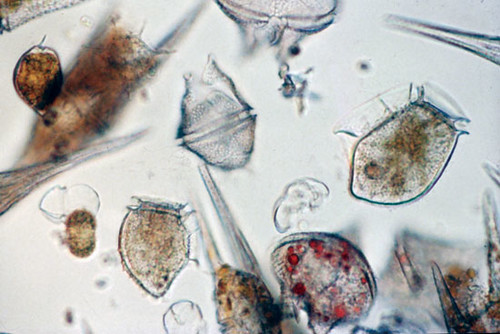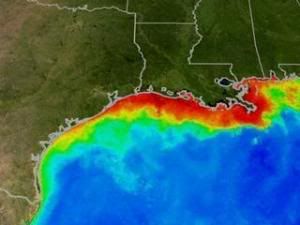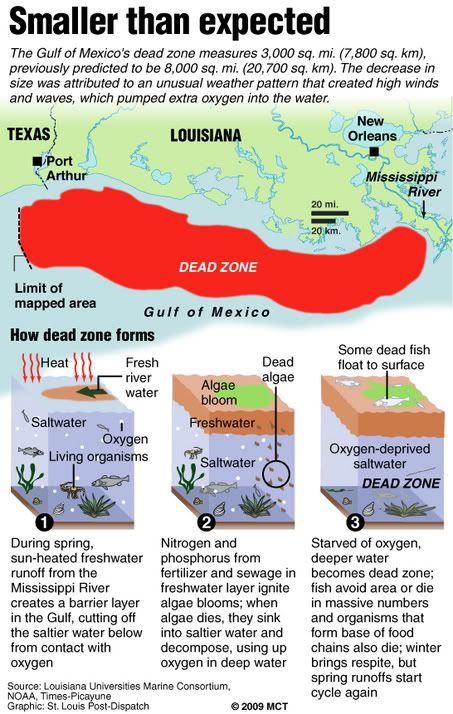(11 am. – promoted by ek hornbeck)
We live on a wonderfully complex planet.
Global Plankton Blooms
http://www.youtube.com/watch?v…
The World contains the systems and feedback cycles to bring things back into balance — given enough time. (like millenniums)
The great plankton blooms of the Oceans is one such cycle, that can potentially capture more carbon than all the forests of the world; while at the same time providing the basis of the food chain, in the world’s greatest food basket. Plankton, not eaten, are destined to become sediment rock, at the bottom of the sea (taking all that harmful CO2 with them).
Problem is, plankton blooms, have been fading, by as much as 30% due to rising Ocean temperatures. IPCC estimates that “80% of the heat that is being trapped by greenhouse gases is absorbed by the ocean.”
Humans have the know-how to “kick start” those Plankton Blooms back to their previous splendor —
Question is: Do we dare to use the Earth as a giant Test Tube?

Algae and Plankton are “the weeds” of the Ocean. Scientists discovered over a decade ago, that Iron particles dropped into the Ocean, works like sprinkling “Miracle-Gro” in your garden. Iron works like a Fertilizer, helping everything to “grow like weeds”.
 Natural Iron Fertilization: Sahara Dust Storms Stimulate Huge Plankton Blooms
Natural Iron Fertilization: Sahara Dust Storms Stimulate Huge Plankton Blooms
They observed this “fun fact”, by watching what happens when desert sands blow out onto the Oceans, and watching the Plankton Blooms the show up, as a direct result. Iron (Fe) was soon determined to be the “active ingredient” in such Nature-sponsored CO2-absorbing Experiments.
Nature has for eons, tended to these little known aquatic Gardens:

Problem is as waters continue to warm, and continue to become more and more CO2-saturated, and thus more acidic, the Plankton critters have a harder and harder time, getting started in many places. This is painfully demonstrated along the US Gulf Coast, were the red area, show the newly develop plankton “dead zone”:

However, here’s where our little “lab experiment” of MAYBE seeding the Oceans, gets tricky. Even though warm water turn Plankton to toast, there ARE situations where excessive algae blooms, turn the sea into a Dead Zone. In calm, coastal waters, algae blooms can use up ALL the Oxygen, which can suffocate everything else.
Ominous ‘dead zone’ threatens Gulf of Mexico shrimping
ScienceBlog.com
Hypoxia occurs when increased nitrogen runoff causes algae blooms, which sink into bottom waters and are decomposed by bacteria, a process that consumes oxygen. The warm fresh water from the Mississippi and Atchafalaya rivers also layer atop the colder salty Gulf waters, preventing atmospheric oxygen from getting to the bottom.
[…]
Hypoxia and other problems caused by excess nitrogen load are not unique to the Gulf of Mexico. Resent NOAA reports indicate that this problem occurs in more than 50 percent of US estuaries and the United Nations Environment Program has identified nitrogen overload and its contribution to the rapid growth of oxygen-starved zones in some coastal waters as an emerging global issue.
So, while seeding the Oceans may kick-start the “weeds of the sea” — BEWARE of the law of Unexpected Consequences!

Companies, like Planktos and Climos, have sprung up to demonstrate the feasibility of such planetary plans for Seeding the Oceans with Iron, to fight Global Warming. These Companies based their Business models on Collecting Carbon Credits, to fund their research and seeding efforts. Not surprisingly, opposition groups sprung up to stop the Planetary Tinkering.
Planktos recently has given up the effort, releasing a Press statement:
blaming “ideological hostility to and misrepresentations” for the fundraising woes. “A highly effective disinformation campaign waged by anti-offset crusaders has provoked widespread opposition to plankton restoration,” the release said.
Even Greenies have been railing against such Planetary Experiments, maintaining that more measured green-tech approaches must be “urgently applied” instead. The Debate currently goes like so:
[Ocean Iron fertilization] Debate
While many advocates of ocean iron fertilization see it as modern society’s last best hope to slow global warming long enough to change our consumption patterns and energy systems, a number of critics have also arisen including some academics, deep greens and proponents of competing technologies who cite a variety of concerns.
Precautionary Principle
Critics: We don’t know the possible side-effects of large scale iron fertilization. Not enough research has been done. We should not risk iron fertilization on the scale needed to affect global CO2 levels or animal populations.
Advocates: Similar blooms have occurred naturally for millions of years with no observed ill effects. The precautionary principle provides a legitimate brake on this technique once plankton populations are restored to their known levels in 1980. Up to that point, however, plankton revival is simply eco-healing and little different from remedially treating superfund sites, oil spills or contaminated mothers’ milk. Not even trying to remedy these industrial impacts is far more irresponsible considering the known pace of increasing harm.
http://water.wikia.com/wiki/Ir…
Well, it seems this Debate (about Seeding the Oceans) has recently taken another unexpected turn. The American Geophysical Union (AGU) has just completed its big fall conference where all the leading geophysicists go to report their latest research. These Scientists have released many startling conclusions about Global Climate change, like:
The Antarctic ice sheet hits the fan
Antarctic shrinking much faster than expected
Joseph Romm – The Grist — 15 Jan 2008
… the Antarctic ice sheet — which has 10 times as much ice as Greenland — is losing mass much faster than anyone expected. And the rate of ice loss has quickened in the last decade. In fact, 2007’s ice loss was 75 percent higher than 2006’s.
Jeez, it’s almost like … I don’t know … the whole friggin’ planet is melting, and we are to blame! If only we had a group of scientists who would, like, report regularly on the impending catastrophe and explain to us how to avoid it …
(Emphasis added)
and here’s Another AGU stunner: Evidence that Antarctica has warmed significantly over past 50 years.
Another of the unexpected ideas postulated at the AGU conference, has a direct impact that the Seeding the Ocean Debate. It seems that Debate may have finally reached a new Urgency “Tipping Point”. Desperation and expediency may indeed, end up dictating that such Extreme Measures are taken, as a sort of pragmatic last ditch resort, to save the Planet.
Dr. James Hansen, the censored NASA scientist, who help coined the term “Tipping Point”, is NO Longer sitting on the fence, about the need for conducting Planetary Geo-Engineering:

In the Q & A session after Jim Hansen’s talk about the dire state of the earth at the AGU meeting, eminent Rutgers University professor Paul Falkowski asked Hansen: “The genie is out of the bottle now — What do you think of geoengineering as a way to deal with global warming?”
I half-expected Hansen to throw his laser-pointer at Falkowski. After all, geoengineering — deliberate, large-scale manipulation of the earth’s climate — has long been a taboo subject in the climate debate. Only crackpots brought it up.
But Hansen didn’t miss a beat. He said it would make sense to try “soft” geoengineering first, such as no-till agriculture and afforestation. But as a last resort, Hansen admitted, more aggressive geoengineering schemes might be necessary. Call it prudence. Or desperation.
(Emphasis added)
Source: How desperate are climate scientists?
Desperate enough to contemplate geo-engineering
Joseph Romm – The Grist — 21 Dec 2008
So there you have it, even with the inherit danger, Climate Change expert Dr. James Hansen, thinks that Planetary Geo-Engineering is something we should consider, and be prepared to used, if it comes to that.
So the Question: If Science could adequately mimic Nature’s Ocean Fertilizer, and safely promote the growth of these wonderous CO2-loving critters, SHOULD WE, dare to?



Does having the technical knowledge on how to change the Planet, and hopefully fix the Planet, give us the right to do so?
What DO you think?
Some day soon, these will be the Hot Debates, of the future. Are we smart enough? Are we wise enough? Are we desperate enough to begin to Seed the Oceans?
(Many have already registered some well-considered and varied opinions on the subject, here on the Grist.)
Should we Seed the Oceans, to Reverse Runaway CO2 Rates?
(or can we count on people to “just change their ways”, fast enough, to make a real difference?)
Should technology try to Save the Day — and prevent the Greenhouse, Desert world?
Or should we all become Luddites, or Underground Mole-People?
What say you?
Kind of makes an old-timer nostalgic for the good old days, when we only had Acid Rain to halt, and an Ozone Hole to patch. … Oh, for those “simple problems” now. … Of course back then people generally thought, if we could, we should, fix the Environment — these days, who can say? …
There’s seems to be a negative feedback cycle at work now. … A downward spiral between Hopeless … and … Helpless … and back again. Round and Round we go …


14 comments
Skip to comment form
Author
this is really out of the box thinking —
but it may one day come to that.
a la blacken the sky as in the movie seried The Matrix to shield against “global warming”?
Does the US Air Force have the right to own the weather by 2025?
Can we detect “threats” to “our” “security” by spraying the sky with substances which reflect over the horizon radar signals.
Orwellian doublespeak bullshit items denoted by quotes.
Or should we just de-populate by 80%.
to replace loss of ice at the poles which I read about somewhere–seems simple, seems like it might help.
That was the good old days, indeed.
Those CO2 critters are pretty little things, I think we should let a few of them go and see what happens. Can’t get any worst, can it?
We are in Adapt or Die mode. We have been for some time now. Best get used to it and plan and study accordingly.
Fertile land and decent rainfall will be the real wealth of the latter part of this century. Could be why the Bush family is buying up so much land in Paraguay. Then again, they could just want to be among their own kind.